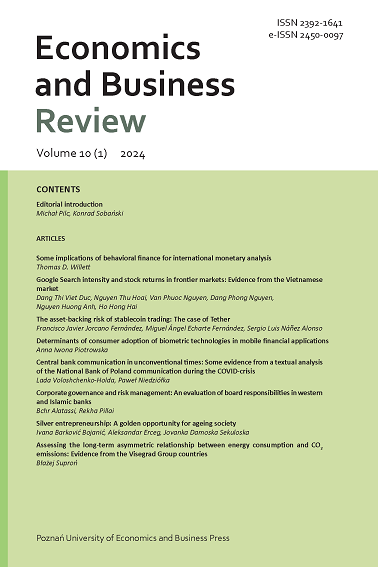ISSN 2392-1641
e-ISSN 2450-0097
DOI: 10.18559/ebr
The Economics and Business Review (earlier as the Poznan University of Economics Review) has been published by Poznań University of Economics and Business Press since 2001. The EBR provides a platform for academicians all over the world to share, discuss and integrate state-of-the-art economics and finance thinking with a special focus on emerging market economies.
The EBR invites submissions of original and unpublished articles. The journal is published in English only, with a frequency of four issues yearly. Texts are double-blind reviewed.
EBR is an open access journal. To submit, process and publish an article in Economics and Business Review authors are not required to pay any charge.
|
Impact Factor 2022: |
0.7 |
|
CiteScore 2022: |
1.4 |
Thematic issue: Large language models in economics and finance
Economics and Business Review currently invites submissions for a thematic issue on large language models. Please check the call for papers.
The Economics and Business Review journal received a grant within the Development of Scientific Journals programme of the Minister of Education and Science of Poland. Years 2022-2024, contract no. RCN/SP/0242/2021/1, financing 73 200 PLN. The project aims to maintain and improve editorial standards, increase the reach and impact of the journal, and modernize the journal website.

It may seem that there is nothing special in the way people use money; they have been using it for many centuries. Yet recent technological changes, external shocks, growing welfare and also advancements in the field of economics have changed the way the financial markets behave and the way they are described. The current issue of Economics and Business Review reflects that trend, because it focuses heavily on financial topics. It consists of eight articles written by nineteen authors who work in Croatia, North Macedonia, Poland, Spain, the United Arab Emirates, the United Kingdom, the USA, and Vietnam. The authors use quantitative and qualitative methods to answer their research questions, which hopefully would be of interest not only to researchers but also to practitioners and policymakers (...) (Michał Pilc, Konrad Sobański).
ISSN 2392-1641
e-ISSN 2450-0097
DOI: 10.18559/ebr
Impact Factor: 0.7
CiteScore 2022: 1.4
SJR 2022: 0.169
SNIP 2022: 0.579
ICV 2022: 120.81
JCI 2022: 0.27
MNiSW: 70
ABDC- JQL: C
The Economics and Business Review journal received a grant within the Development od Scientific Journals programme of the Minister of Education and Science of Poland. Contract number RCN/SP/0242/2021/1


Editorial Office: Economics and Business Review
Collegium Altum
ul. Powstańców Wielkopolskich 16, room 109
61-895 Poznań, Poland
secretary@ebr.edu.pl
Publisher&Owner: Poznań University of Economics and Business Press
al. Niepodległości 10
61-875 Poznań, Poland
https://wydawnictwo.ue.poznan.pl
Publisher's office: wydawnictwo@ue.poznan.pl
phone +48 61 854 31 54
